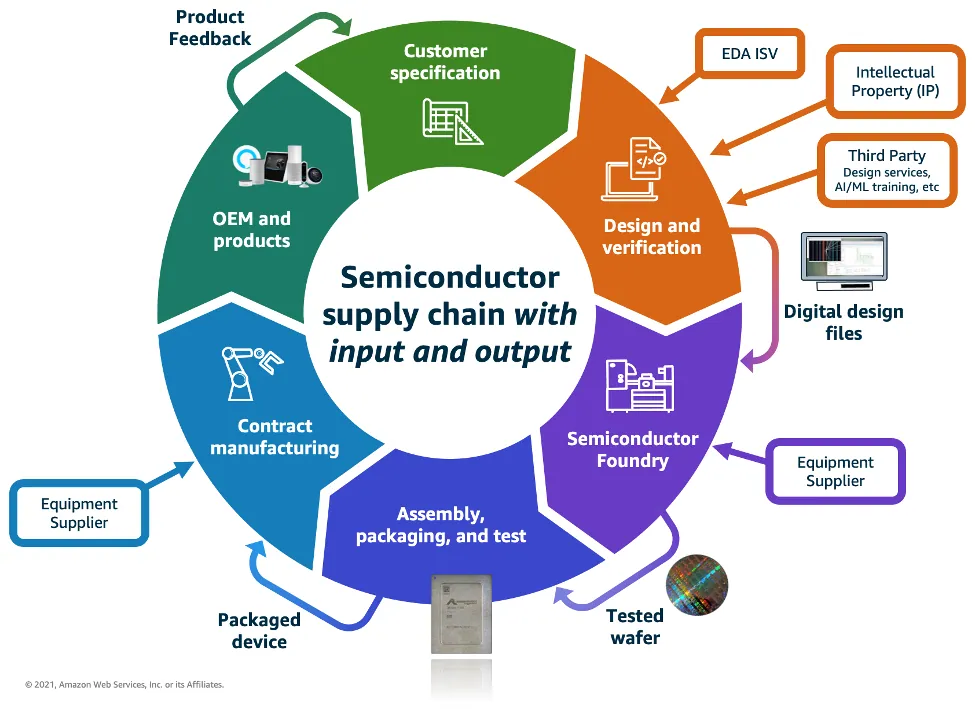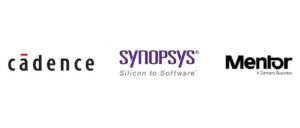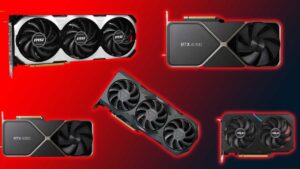Introduction
The semiconductor industry is a thriving ecosystem characterized by a meticulous value chain, encompassing diverse stages from product conception to the integration of electronic components into end-user devices.
Imagine our smartphone processor as the engine of a high-performance car. The product design is the blueprint for the engine, IC design is the engineering of the engine components, fabrication is the actual manufacturing of the engine, OSAT is the quality assurance testing, and end-user integration is the assembly of the engine into the car.
In this blog post, we will explore the intricacies of the semiconductor value chain, shedding light on each stage’s significance and the engineering support that propels innovation forward.
Throughout our exploration, we’ll follow the hypothetical development of a smartphone processor, providing tangible examples of companies at each stage.
1. Product Design: Inspiring Innovation (Profit Margin: 30-40%)
In the semiconductor value chain, product design refers to the initial phase where engineers and designers conceptualize the architecture and features of a semiconductor device, such as a microprocessor or integrated circuit.
This stage involves creating a detailed blueprint that outlines the functionalities, specifications, and overall structure of the semiconductor product, laying the foundation for subsequent stages of the value chain.
Consider a tech giant like Apple, renowned for its innovative products. In this phase, Apple’s design team conceptualizes the architecture and features of a groundbreaking smartphone processor, aiming for a profit margin between 30-40%.
Engineering Support:
- a. Electronic Design Automation (EDA): Synopsys and Cadence Design Systems provide EDA tools facilitating the design and simulation of our processor.
- b. IC Design Houses: ARM, a leading IC design house, contributes intellectual property (IP) for processor cores.
Read More: Top 10 Semiconductor Companies of Europe by Market Cap in 2023
2. IC Design: Turning Concept into Blueprint (Profit Margin: 40-50%)
In the semiconductor value chain, IC (Integrated Circuit) design involves the translation of the conceptual product design into a detailed and functional circuit blueprint.
IC designers, often working for fabless companies or Integrated Device Manufacturers (IDMs), focus on creating the intricate layout of transistors, interconnections, and other components that constitute the integrated circuit, ensuring it meets performance, power, and size requirements.
Engineering Support:
- a. IP Integration: Rambus, a provider of semiconductor IP, enhances the IC design process with crucial components.
Read More: Top 10 Semiconductor Equipment Companies of 2023
3. Fabrication: Crafting the Core (Profit Margin: 30-40%)
In the semiconductor manufacturing process, the fabrication or foundry stage involves the transformation of raw materials into silicon wafers, which serve as the foundation for integrated circuits. This stage is crucial for the production of semiconductor devices. Let’s delve deeper into the components mentioned:
i. Materials, Metal Target, Wafers:
- Materials: Raw materials such as silicon, used in the form of crystalline ingots, are essential for creating the silicon wafers.
- Metal Target: In certain processes like sputtering, a metal target is used to deposit metal layers onto the wafer’s surface.
- Wafers: Thin, circular slices of semiconductor material (usually silicon) act as the substrate for building integrated circuits.
ii. Chemicals – acids, alkali, solvents:
- Acids, Alkali, Solvents: Various chemicals are employed in different stages of wafer fabrication. Acids, like hydrochloric acid or sulfuric acid, may be used for etching, while alkali solutions can be used for cleaning and certain chemical treatments. Solvents are utilized for cleaning and removing residues from the wafer surface.
iii. Gases – bulk gases (N2, Ar) and specialty gases (Silane, Diborane, etc.):
- Bulk Gases (N2, Ar): Inert gases like nitrogen (N2) and argon (Ar) are used for purging and maintaining controlled atmospheres within fabrication tools.
- Specialty Gases (Silane, Diborane, etc.): Specialized gases such as silane and diborane are critical for specific processes like chemical vapor deposition (CVD) and doping, contributing to the modification of the wafer’s surface properties.
b. Equipment is supplied to fabricate the wafers:
- i. Wafer Processing Tools (e.g., Lithography, Plasma Processing for Deposition & Etch):
- Lithography: Involves the use of photolithographic techniques to transfer the circuit pattern onto the wafer surface, defining the features of the integrated circuits.
- Plasma Processing (Deposition & Etch): Plasma-based processes are used for depositing thin films (deposition) and selectively removing material (etching) from the wafer, crucial for creating the multiple layers that form the integrated circuits.
- ii. Facilities Tools for Servicing the Wafer Processing Tools:
- Facilities tools: These tools include utilities and support systems necessary for maintaining the optimal working conditions of wafer processing tools. This encompasses environmental controls, vacuum systems, and other infrastructure to ensure precise and reliable semiconductor fabrication processes.
The silicon wafers housing our processor come to life in the fabrication stage, with TSMC (Taiwan Semiconductor Manufacturing Company) as a prime example. TSMC transforms the design into a tangible product, achieving profit margins of 30-40%.
Read More: 4 Reasons Why Big Tech Companies are Designing their Silicon Chips?
Engineering Support:
- a. Material Supply: Applied Materials delivers essential materials and gases required for the fabrication process.
- b. Equipment Supply: ASML provides cutting-edge lithography equipment vital for the fabrication of our processor.
4. Outsourced Sort Assembly and Test (OSAT): Ensuring Quality (Profit Margin: 25-35%)
In the semiconductor value chain, OSAT (Outsourced Semiconductor Assembly and Test) refers to the specialized companies that undertake the final stages of semiconductor manufacturing, including the assembly, testing, and packaging of integrated circuits.
OSAT providers play a crucial role in ensuring the quality, functionality, and reliability of semiconductor products before they are integrated into end-user devices.
Engineering Support:
- a. ATE Manufacturers: Teradyne supplies assembly test equipment essential for verifying our processor’s functionality.
- b. Materials Suppliers: Companies like Dow contribute materials crucial for the assembly and testing equipment.
Read More: 12 Semi Companies with Returns Beating S&P 500 Index Fund
End-User Integration: From PCBs to the Palm of Your Hand
The final leg of our journey involves end-user integration, where companies like Foxconn specialize. Foxconn assembles PCBs, mounting our processor onto them. This phase also includes additional components, enclosures, and displays, resulting in the creation of a complete smartphone.
Engineering Support:
- a. EMS Equipment: Juki provides the equipment needed for Electronic Manufacturing Services, ensuring efficient and precise assembly.
Conclusion:
In conclusion, the semiconductor value chain is a dynamic and interconnected journey that transforms innovative ideas into tangible technological marvels. From conceiving the blueprint for semiconductor devices at the inception of product design to undertaking the meticulous fabrication process and engaging in intricate IC design, each stage actively plays a pivotal role in bringing cutting-edge technology to fruition. The support provided by engineering disciplines, materials suppliers, and equipment manufacturers ensures the seamless progression through the value chain, culminating in the critical stages of Outsourced Sort Assembly and Test (OSAT) and end-user integration.



